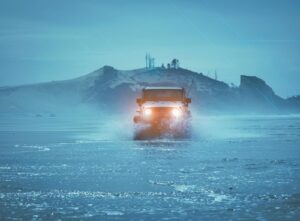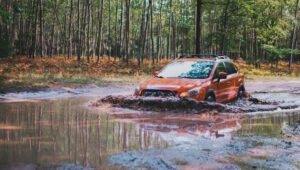Engine hydrolocking and many other jeep components can damage while off-roading through water.
So in this article I hope to take you through an in depth guide about hydrolocking, how to prevent hydrolocking, what are the other complications that can happen while water crossings and how to prevent them.
So this is going to be an interesting guide. Let’s get started !!
Contents
What is engine hydrolocking?
Engine hydrolocking is an engine cease or damage of internal components of an engine due to entering a substantial volume of water/liquid to the combustion chamber.
That is a simple explanation for engine hydrolocking. There I had mentioned ” water/ liquid”.
That’s because flooding excessive amounts of fuel/ engine coolant to the combustion chambers due to a failure also leads to hydrolocking.
What amount of liquid in combustion chambers may lead to hydrolocking?
When the piston of a combustion chamber comes to its highest level(end of the piston stroke), there’s a minimum volume remaining above the piston head.
If the volume of any liquid enters a combustion chamber greater than that above mentioned minimum volume, that can lead to a hydrolocking.
But the amount of damage that can happen to an engine will differ.
That mainly depends on the type of engine.
If the engine generates high power and torques, the amount of damage can happen to that engine also high.
The reason is simple. I’ll tell you about it after discussing the below topic.
How does the engine be hydrolocked?
As I mentioned earlier a liquid should enter the combustion chamber for hydrolocking of an engine. So that can happen in many ways.
Water can enter the engine through air intake. This is a very common reason.
Especially our off-roading pals may face this. If you drive your off-roading vehicle through a water puddle / river bed and the depth of water is higher than the level of your air intake, water will enter to the air intake.
This will usually happen.
Even the depth is not higher than the air intake level, hydrolocking can happen, if you drive fast through water.
Because driving fast through water will make tall bow waves infront of hood.
That also helps the water to enter through air intake.
Apart from that main reason, there are few other reasons for engine hydrolocking.
There may be a failure in engine head gaskets. That can lead to a leakage of radiator coolants into the combustion chamber.
So that can also cause hydrolocking.
Due to a malfunctioning of fuel injectors, excessive amounts of liquid fuel can flood the combustion chamber.
It may also lead to engine hydrolocking.
Some car users lower the air intake level about the front bumper level to get a cold air intake.
But lowering that air intake level means they are increasing the possibility to saturate their air filters with water.
Even driving through a low depth water puddle can lead water to the air intake.
What happens after liquid enters the combustion chamber?
Internal combustion system created to burn a pressurized gas. The pressure created by burning that fuel and air mixed gas push the piston down.
At one time in it’s cycle, the piston comes up compressing the fuel air mixture to their minimum volume.(end of piston stroke)
If any liquid volume, higher than that minimum volume had entered the combustion chamber what can happen?
Internal components of the engine can’t handle that stress.
Because those metal components are made to compress a gas. If they have to compress a liquid, mostly the connecting rods tend to bend.
If the force is high they can fully snap and bounce around the cylinder or into the crankcase. That can cause huge damage to the engine.
Engine may need to be completely replaced in such situation.
Amount of damage differs from engine to engine..
As I mentioned earlier if the engine has a high power and torque damage is high.
Because the power of pushing a piston upwards to compress fuel mixture, by the crankshaft is high.
That means if there is a liquid, the power applied on the piston from above liquid is also high.
So the possibility to bend the connecting rods and other components is also high.
Normally diesel engines have a higher possibility of damage by hydrolocking than a petrol engine.
There are few reasons for that. The minimum volume in a diesel combustion chamber is lower than a petrol engine.
It’s because diesel engines normally don’t have spark plugs to ignite the gas mixture.
It ignites automatically by producing very high pressure in the mixture by compressing to a very low volume than a petrol engine.
That means the minimum volume of liquid that can enter a diesel combustion chamber is lower than a petrol combustion chamber.
Another reason is diesel engines generally produce a higher power and torque than a petrol engine.
That increases the amount of damage that can happen to the engine components as I described earlier.
What are the symptoms of a hydrolocked engine?
The symptoms will depend on the amount of damage happened to your engine.
If you drive your vehicle engine in idle/low RPM when water enters the combustion chamber and volume of water entered is also less, the damage also less.
You may feel a miss and roughness from the running engine in that kind of condition. That water may get out through the exhausts.
But if the volume of water entered into the chambers high you will hear a knocking sound from the cylinder filling up and your engine will suddenly shut off in one or two seconds.
It will never turn on again.
How to repair a hydrolocked engine?
Hydrolocked engine repair will differ from a simple plug and oil change to a total engine replacement.
First you have to remove water from the cylinders.
If your engine has sucked a little amount of water/ it’s in the idle when hydrolocking, repairing it may not be a huge problem.
You just have to remove your spark plugs (if it’s a petrol engine) or remove injectors(if it’s a diesel engine) and crank over.
Cranking a few times will remove most of the water from the cylinders.
Then replace with a new set of spark plugs and change the oil. It will restore your engine.
Keep in mind to track where wires go/ firing order when removing spark plugs.
But if your engine was running above idle when hydrolocking, there is a huge probability to damage internal engine components.
In that case, your engine has to be pulled out and stripped down.
Then have to check for the bent connecting rods, damaged crank shafts, bearings, piston heads.
Even the engine blocks should be tested for cracks. That means a full engine components test should be done, one by one.
Repair the hydrolocked engine as soon as it hydrolocked.
Because water in the engine causes a lot of damage. Cylinder walls and those internal components corrode easily.
So be careful about that if you take a while to do your repairs.
How to avoid hydrolocking?
First thing is don’t drive through water levels higher than your air intake.
In most of the off-roading guides I had talked about this. Know the depth of water before crossing it.
As an off roader you can increase your water crossing capabilities by attaching a snorkel to your jeep.
I had written a snorkel guide. You can check that also by clicking here.
As a quick recap, snorkel can raise your stock air intake level up to your roof level.
This height may differ from snorkel type. But technically, raising your air intake increases your vehicle’s capability when crossing water.
It can travel more deeper in water than without a snorkel. But keep in mind snorkel prevents only the water entering through your air intake by increasing it’s height.
In jeep wranglers there’s an air intake near the gas filling line. It sucks air in, to clean out the gas fumes in the evap canister.
It is not visible from outside. But it is very important to know that there’s a hole that water could enter into your gas tank when you drive through water.
If your jeep’s gas cap is under water when you are stuck in water, don’t try to start the engine.
There’s a possibility that water may enter the gas tank through that air vent.
If that has happened, your engine will hydrolocked if you try to start it.
What are the other complications that can happen in your jeep by off-roading in water?
Water can damage many other components in your jeep.
Especially your electronic systems, engine control units / computer systems , clutch units, brakes and many more.
Do’s and dont’s to when stuck in water to avoid other complications by off-roading in water?
To avoid damaging your electronic components with water , you should know the places where your electronics are placed under the hood.
You should avoid putting your jeep deeper than those levels when crossing water.
If your manual transmission jeep is stuck in the middle of water crossing, don’t try to push the clutch to re-start the engine.
Because the vacuum created inside the clutch unit by pressing the clutch is enough to suck harmful amounts of water/mud into the housing.
I have clutch and pressure plate replacement experience from doing that.
So if you want to start your engine in such a situation, put the transfer case into 4L and put transmission into 1st gear.
Then you can start your engine without pressing the clutch and take your jeep out of the water.
If you have an automatic transmission jeep it’s not a problem. You can just start and drive the jeep.
When talking about brakes, they also can suck water.
So it’s better to press your brake peddle few times to evacuate that water after crossing water puddles.
Last but not least there are diff breathers that can suck small amount of water if the water level is more than 30inches in a jk.
So check that out also after being stuck in water.
So far I think I had covered all the things you should aware about hydrolocking your off-roading engine.
If you think this article may help to save engine of any of your off-roading pal, share this with them. You just have to hit a share button below.
Have fun and safe off-roading !!



